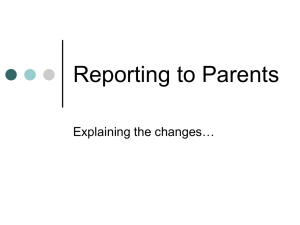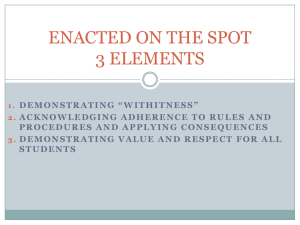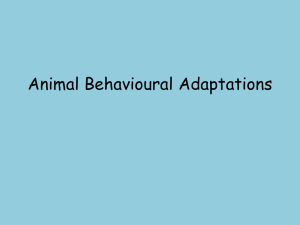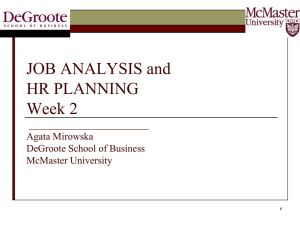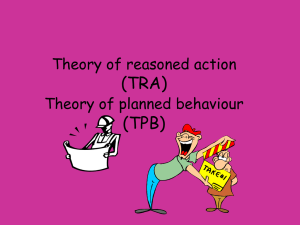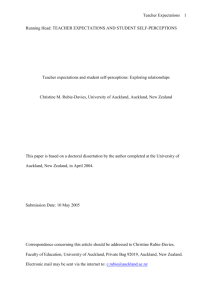Workshop 1 - University of Auckland
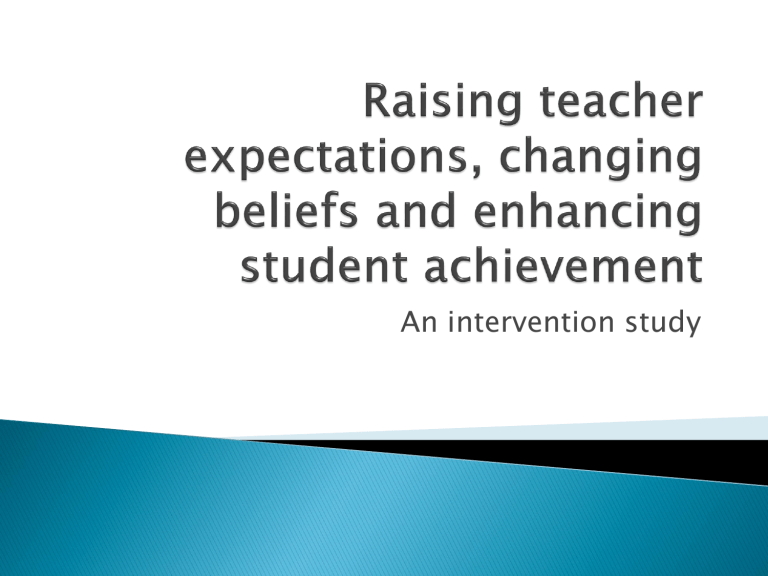
An intervention study
Introductions
◦ Teachers
◦ Researchers
Outline of the project
◦ Questions
◦ Understandings/expectations
9.45 – Research background:
◦ Rosenthal
◦ Teacher behaviours
◦ Student characteristics: Gender, social class, ethnicity
10.30 – Morning tea
11.00 – Characteristics:
◦ Student characteristics: ethnicity
◦ Teacher characteristics: Babad, Weinstein, Rubie-Davies
12.15 – Lunch
1.15 – Whole class expectations:
◦ The evidence
◦ View/analyse own videos
◦ Areas for development: grouping and learning experiences, motivation and evaluation, class climate and student responsibility for learning
◦ Identification of areas for growth
Rosenthal and Jacobson
◦ Rosenthal and rats
◦ Experimenter effects
◦ Expectations in classrooms
◦ Pygmalion in the classroom
◦ Conclusions
◦ Controversy
Formation of
Class
Expectations
Teacher
Beliefs
Socioemotional Environment
Opportunities to Learn
Instructional
Practices
Student
Outcomes:
Social/Academic
Instructional Environment
Formation of expectations
Personality correlates of teachers
Transmission of differential expectations
Student perceptions
Educational and social outcomes
Greater influences Lesser influences
Portfolio information
Gender
Ethnicity
Social class
Diagnostic labels
Attractiveness
Siblings
Names
Language style
Personality and social skills
Teacher/ student background
3.
4.
5.
6.
1.
2.
7.
8.
9.
10.
Wait time less for lows
Give lows the answer/ ask someone else
Inappropriate reinforcement
Criticising lows for failure
Praise lows less for success
Fail to provide feedback to public response of lows
Pay less attention to/ interact less with lows
Call on lows less frequently
Seat lows farther from the teacher
Demand less from lows
11.
12.
13.
closely
Differential grading of tests
14.
15.
with lows
Less informative feedback to lows
Lows receive less eye
16.
17.
communication
Less intrusive instruction of highs
Less use of effective
Brophy (1985) behaviours towards low expectancy students
not helping enough to improve students’ answers praising incorrect answers or inappropriate behaviours demanding less of them shorter and less informative feedback less intrusive instruction less use of timeconsuming instructional methods
Good and Weinstein (1986) teachers provided less capable students with:
less opportunity to perform publicly less opportunity to think and analyse less choice on assignments/ tasks less autonomy and more frequent monitoring more gratuitous and less contingent feedback
Development of research into teacher differential behaviour
Positives and negatives related to teacher differential behaviour
Climate
Feedback
Input
Output
Stronger effects for affective climate and instructional input
A smaller effect for output
A practically negligible effect for differential feedback behaviours
1.
2.
3.
4.
5.
What are the specific types of differential behaviours?
What is the ideological legitimacy and educational desirability of each type of differential behaviour?
Which group of students receives an advantage from each type of teacher differential behaviour?
What is the teachers’ natural tendency and how would they wish to deal with particular students and different groups of students?
To what extent are teachers able to control their specific verbal and non-verbal behaviours?
The components of the theory clash
Affective displays and actual feelings
Controlling affective displays: verbal and non-verbal
Do students perceive teacher differential behaviour?
Interpreting behaviours differently
Perceptions of teacher interactions
Is there agreement in relation to degrees of learning support?
Is there agreement in relation to degrees of emotional support?
Effects on students
Classroom climate and morale
Fairness and equity
Social comparison process is powerful and prevalent in schools
Adams (1965)
◦ Balance between what we put in and what we get out
◦ Influenced by others
Sense of justice
Student characteristics
◦ Ethnicity
Teacher characteristics
◦ High bias and low bias teachers: Babad
◦ High differentiating and low differentiating teachers: Weinstein
◦ High expectation and low expectation teachers:
Rubie-Davies
Gender
Ethnicity
Social class
Diagnostic labels
Physical attractiveness
Language style
Personality and social skills
Teacher/student background
Names
Other siblings
Primary school girls
Secondary school boys – maths, science
Ability/effort
Teacher interactions
PE
Reading and language
Social behaviour
Middle class students are expected to perform at higher levels than lower social class
Low social class are vulnerable to teacher expectations
Some evidence teachers’ assessments for lower class are accurate but over-rate middle class
But what about NZ?
Expectations vary according to whether or not a child has a label, e.g. ADHD
Stinnett (2001): 144 preservice teachers
◦ ADHD, no label; Ritalin, in Special Ed
◦ Description of child; vignette
Rubie-Davies
Physical attractiveness
Language style
Personality and social skills
Teacher/student background
Names
Siblings
Rubie-Davies
African American/ White students
Hispanic/ White students
Vulnerability
UK
But what about NZ?
◦ St George (1983) academic
◦ Stoddart (1998) social skills
◦ Rubie-Davies, Hattie, Hamilton (2006)
Rubie-Davies
Rubie-Davies (2006) British Journal of
Educational Psychology
21 teachers
◦ 540 students
261 NZ European
88 Maori
91 PI
94 Asian
Rubie-Davies
Expectation survey
◦ 1-7 Likert scale
Teacher judgement of student achievement
Running records
Rubie-Davies
Expectation and achievem ent by ethnicity
5
4.5
4
3.5
3
2.5
2
1.5
1
0.5
0
NZ European Maori Pacific Island
Student ethnicity
Asian
Rubie-Davies
Expectation
Achievement 1
6
5
4
3
2
1
0
NZ European
Teacher judgem ent and student achievem ent by ethnicity
Maori
Ethnicity
Pacific Island Asian
Judgement
Achievement 2
Rubie-Davies
3 3.2
Effect Size Gain by Ethnicity in Reading
3.4
0.5
3.6
3.8
0.45
0.4
0.35
0.3
0.25
0.2
0.15
4
0.1
0.05
0
Teacher Expectation
4.2
4.4
4.6
4.8
NZ European
Maori
Pacific Island
Asian
Rubie-Davies
Teacher expectations
◦ Ethnicity or social class?
Societal stereotypes
Lowered expectations
◦ Effect on pedagogy
Lesson pace
Structured environment
Ability
Self-fulfilling prophecy effect/ sustaining expectation effect
Rubie-Davies
Prejudice (bias) is a negative attitude
A stereotype is a generalisation, a belief
http://www.understandingprejudice.org/iat/
A belief about the personal attributes of a group of people
Stereotypes are sometimes over-generalised, inaccurate and resistant to new information
Stereotypes are shortcuts
Stereotypes are biased
Problems with the use of stereotypes
Prejudice: A set of negative stereotypes loaded with aggression and strong emotions carrying the idea that ‘we’ are better than
‘them’
Often based on commonly held stereotypes
What is teacher bias?
Objectivity appears to be difficult
Experimental vs naturalistic studies?
Reversed bias
Reducing bias
Babad (1998) Draw-a-Person Intelligence test
◦ One-sixth of teachers objective
◦ One half mildly biased
◦ One-quarter highly biased
◦ A small proportion reverse biased
In theory
In practice
Personality questionnaire
Classroom behaviour
Elisha Babad
Rhona Weinstein
Christine Rubie-Davies
Preferential affect is at the heart of the teacher expectation issue
Identified high and low bias teachers
Video clips
Ten-second exposure
Babad’s studies in elementary and secondary schools and at university
Babad et al, 1989; 1991; Babad & Taylor,
1992
◦ Adult judges of teacher non-verbal behaviour
◦ What young students perceived in teachers’ nonverbal behaviour
◦ Students from different grade levels
◦ In Israel and New Zealand
◦ Students made guesses about the student the teacher was talking to or about
◦ Results
Students live different lives in one classroom
Student perceptions of differential treatment in the classroom
High achievers
Favoured in teacher interactions
Higher expectations
More opportunity and more choice
Low achievers
Receive more frequent negative feedback
More teacher-directed treatment
Teacher is the defining agent of ability not themselves, peers or parents
Public incidents
Importance of nonverbal cues
Children relate smartness to conforming behaviour and fast completion of work
Effects on children’s feelings
Ways in which students are grouped for instruction
Materials and activities through which the curriculum is taught
Evaluation system that teachers use to assess learning
Motivational system used to engage students
Responsibility that students have in directing and evaluating learning
Climate of relationships within the class, with parents and with the school
Ability grouping
Highly differentiated curriculum
Intelligence is fixed
Learning for external reward
Teacher as director
Teacher as academic instructor
Variety of grouping
Challenging learning experiences
Intelligence is malleable
Learning for personal growth
Teacher as facilitator
Teacher as socialiser
The question is not, what is it about students that mean teachers have high or low expectations for them; the question we should be asking is, what is it about teachers that means some have high or low expectations for all their students?
What do we portray in our verbal and nonverbal behaviour?
Lie to Me video clip
What kinds of messages are you delivering to students? Verbally/ non-verbally?
Is there any evidence of bias?
What is it like for students to be in your class?
What does your body language tell students?
Teacher Expectation and Student Achievement
Mean expectation and achievement
4
3
2
1
0
7
6
5
1 2 3 4 5
Teacher number
6 7 8 9
Reading exp
Reading ach 1
0 1 2
Effect Size Gain vs Expectation in Reading
1.6
1.4
3
1.2
1
0.8
0.6
0.4
4
0.2
0
-0.2
Teacher Expectation
5 6 7
HiEx Group
LoEx Group
S t u d e n t S e l f P e r c e p t i o n s i n R e a d i n g a n d M a t h s
2 9
2 8
3 1
3 0
3 4
3 3
3 2
Readi ng Hi E x Readi ng LoE x M at hs Hi E x
S t u d e n t s e l f p e r c e p t i o n s b y t e a c h e r t y p e
M at hs LoE x
B egi nni ng y ear
E nd y ear
Student Perception of Teacher Opinion of their Performance
8.8
8.6
8.4
8.2
8
Means
7.8
7.6
7.4
7.2
7
High
Teacher Expectation of Students
Low
Beginning of Year
End of Year
Luke: “A lot of repetition, every day…until they can start recalling their basic number facts.”
Hannah: “They need activities that are challenging so they are motivated. If I don’t make them independent as well [as the high ability students] they won’t learn to run by themselves. They’ll always need the teacher.”
Teaching statements: orienting students to the lesson, introducing and explaining new concepts, using student prior knowledge
Feedback to students
Open and closed questions
Positive and negative behaviour management
Procedural statements
High expectation teachers: a facilitative approach
Low expectation teachers: a directive approach
Mixed ability groupings
Worked with a variety of peers
Well-defined learning goals
Responsibility for learning
Choices in learning experiences
Intrinsically motivated
Frequent feedback
Answering open questions that challenged thinking
Extended explanations of new concepts
Positive social climate
Teacher defined activities
Extrinsically motivated
Worked in ability groups
Little mixed ability interaction
Less ownership of learning
Unsure of learning direction
Answering closed questions
Limited explanations of concepts
Plenty of procedural directions
Negative social climate
Grouping
Learning activities
Classroom climate
Student responsibility
Motivation
Evaluation
Teacher journals
◦ Comments on the day – how are you feeling?
Did you learn anything?
Did anything surprise you?
Did you enjoy the day?
What will you take back to your class?
Anything you are thinking about changing?
◦ Possible areas for development?


